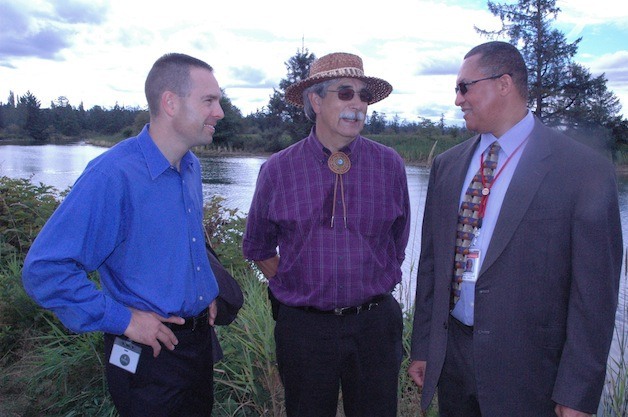MARYSVILLE — A 45-minute walk into the wetlands just south of Marysville culminated in the ceremonial turning of shovelfuls of earth on the morning of Tuesday, Aug. 27, to mark that the Qwuloolt Estuary Restoration Project is officially underway.
Dozens of area dignitaries — including state senators Steve Hobbs and Mike Sells, Snohomish County Executive John Lovick and former Marysville Mayor Dennis Kendall — were escorted through the site by Kurt Nelson, environmental division manager for the Tulalip Tribes, who explained that the Tribes partnered with a number of city, state and federal agencies to restore tidal access to approximately 360 acres of historic floodplain.
“Since 1994, we’ve had 22 sources of funds,” said Nelson, who estimated the total project cost will come in at roughly $9 million, and estimated that the channel work and ditch filling that began in 2007 will finally wrap up this year, and that the replanting of native vegetation that began in 2011 would be completed in 2014.
The U.S. Army Corps of Engineers awarded a contract to the Auburn-based Sealaska for a $3.73-million portion of the project which will be carried out in two phases. Construction began Monday, Aug. 19, on phase one, which will carve out a 4,000-foot setback levee to protect Brashler Industrial Park, the Marysville Wastewater Treatment Plant and the surrounding areas’ residents. According to Nelson, next year will kick off phase two, which will lower 1,400 feet of the Ebey Slough dike, then excavate a 270-foot breach in it to allow tidal inundation. These measures are intended to reverse the installation of tide gates and the building of the dike on the estuary early in the 20th century, in order to boost the survival rates of endangered Chinook salmon, bull trout and steelhead.
During a luncheon for the Qwuloolt Estuary tour groups at the Hibulb Cultural Center later that same day, Tulalip Tribal Chair Mel Sheldon Jr. claimed “there’s been no bigger supporter” of the Qwuloolt Estuary Restoration Project than U.S. Rep Rick Larsen, and described Marysville Mayor Jon Nehring as “a guiding light” in the progress of the project, which Sheldon compared to a canoe journey down a river with many twists and turns.
“We all had different roles to play,” Sheldon said. “And in the end, we’ve become very close friends over the course of our shared journey.”
Tulalip Tribal Board member Glen Gobin performed a ceremonial song with his fellow Tribal members that they’d been gifted by their elders, which he asserted made it appropriate for the occasion, as he asked the luncheon’s attendees, “How many of you have become elders since this project started? A lot of us had more and darker hair, all those years ago.”
Gobin, an avid duck-hunter who also looks forward to seeing more salmon, expressed his gratitude to all the project’s partners for working together to come up with creative solutions to the frequently daunting obstacles they faced, even as he opined, “We won’t see the benefits of this restoration in our lifetime. This will be for our children and grandchildren.”
“We’re still not done,” said Larsen, who was equally complimentary toward the Tulalip Tribes, the city of Marysville and the U.S. Army Corps of Engineers for what he deemed their tireless persistence in seeing the project through to this point, even as he differed with Gobin by saying, “I actually do think we’ll see the benefits of this project in our lifetimes.”
Nehring likewise lauded Larsen, the Tulalip Tribes, the state Department of Ecology and the U.S. Army Cops of Engineers for their roles in bringing this project to fruition, and agreed that the Qwuloolt Estuary is “one of the most significant restoration projects in the country” for its environmental impact and cultural import.
“There’s a shared cultural history here,” said Nehring, who got to talk to the public about the Qwuloolt Estuary, among other topics, with fellow representatives of the city of Marysville and the Tulalip Tribes at the Marysville Street Festival from Aug. 9-11. “There’s something like 350 different species of birds there, and it’s just such a beautiful setting.”
Nehring plans to establish an interpretive trail in the Qwuloolt Estuary, and thanked the staff of both the city and the Tribes “for a lot of hard work behind the scenes for several years.”
“This project hit all three of our marks,” said Gordon White, shorelands and environmental assistance program manager for the state Department of Ecology. “It’s restored our ecology, it’s restored our community and it’s restored our faith in each other. We want to keep partnering with you on more and more of these projects.”
“It took the commitment and focus of the greater community,” said Olton Swanson, deputy district engineer for programs and project management with the U.S. Army Corps of Engineers. “It showed that the federal government is not the only answer, and really demonstrated what a community needs to get done on its own to get federal funding in the future.”
“I didn’t realize I’d wind up working on this for 10 years, or one-third of my career,” said Nelson, who echoed the praise of the project partners’ patience, perseverance and problem-solving skills. “It can’t take 10 years to do something like this again. We’ve got to get it done sooner.”



